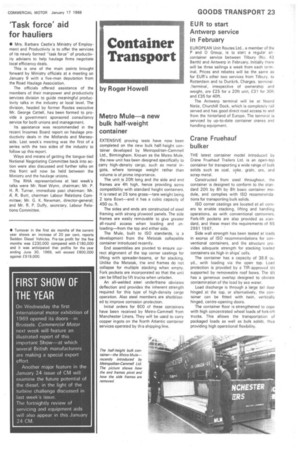Container Transport
Page 25

If you've noticed an error in this article please click here to report it so we can fix it.
by Roger Howell Metro Mule—a new bulk half-weight container EXTENSIVE proving tests have now been completed on the new bulk half-height container developed by Metropolitan-Cammell Ltd., Birmingham. Known as the Metro Mule, the new unit has been designed specifically to carry high-density cargo, such as metal ingots, where tonnage weight rather than volume is of prime importance.
The unit is 20ft long and the side and end frames are 4ft high, hence providing some compatibility with standard height containers. It is rated at 25 tons gross—tare weight being 2 tons 6cwt—and it has a cubic capacity of 450 Cu, ft.
The sides and ends are constructed of steel framing with strong plywood panels. The side frames are easily removable to give greater all-round access when loading and unloading—from the top and either side.
The Mule, built to ISO standards, is a development from the Metstak collapsible container introduced recently.
End assemblies are pivoted to ensure correct alignment of the top corner castings for lifting with spreader-beams, or for stacking. Unlike the Metstak, the end frames do not collapse for multiple stacking when empty. Fork pockets are incorporated so that the unit can be lifted by lift trucks when unladen.
An all-welded steel underframe obviates deflection and provides the inherent strength required for this type of high-density cargo operation. Also steel members are shotblasted to improve corrosion protection.
Initial orders for 600 of these containers have been received by Metro-Cammell from Manchester Liners. They will be used to carry copper ingots on the North Atlantic container services operated by this shipping line.
EU R to start Antwerp service in February EUROPEAN Unit Routes Ltd., a member of the P and 0 Group, is to start a regular allcontainer service between Tilbury INo. 43 Berth} and Antwerp in February. Initially there will be three sailings a week from each terminal. Prices and rebates will he the same as for EUR's other two services from Tilbury, to Rotterdam and to Dunkirk. Charges, terminal/terminal, irrespective of ownership and weight, are £25 for a 20ft unit, £31 for 30ft and £35 for 40ft.
The Antwerp terminal will be at Noord Natie, Churchill Dock, which is completely rail served and has good direct road access to and from the hinterland of Europe. The terminal is serviced by up-to-date container cranes and handling equipment.
Crane Fruehauf bulker
THE latest container model introduced by Crane Fruehauf Trailers Ltd. is an open-top container for transporting a wide range of bulk solids such as coal, coke, grain, ore, and scrap metal.
Constructed from steel throughout, the container is designed to conform to the standard 20ft by 8ft by 8ft basic container module, and complies with ISO recommendations for transporting bulk solids.
ISO corner castings are located at all corners to enable stacking, lifting and handling operations, as with conventional containers. Fork-lift pockets are also provided as standard, and these meet the requirements of BS 2951 1967.
Side wall strength has been tested at loads in excess of ISO recommendations for conventional containers, and the structure provides adequate strength for stacking loaded containers six high in ships' cells.
The container has a capacity of 38.8 Cu. yd., with loading via the open top. Load protection is provided by a TIR-approved tilt supported by removeable roof bows. The tilt has a generous overlap designed to obviate contamination of the load by sea water.
Load discharge is through a large taii door hinged at the top, or alternatively, the container can be fitted with twin, vertically hinged, centre-opening doors.
The container floor is strengthened to cope with high concentrated wheel loads of fork-lift trucks. This allows the transportation of packaged loads as well as bulk solids, thus providing high operational flexibility.








































































































